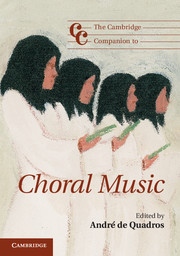Book contents
- Frontmatter
- 1 Introduction: choral music – a dynamic global genre
- Part I Choral music: history and context
- Part II Choral music the world over
- Part III Choral philosophy, practice, and pedagogy
- 15 Globalization, multiculturalism, and the children's chorus
- 16 Exploring the universal voice
- 17 Authentic choral music experience as “good work”: the practice of engaged musicianship
- 18 The making of a choir: individuality and consensus in choral singing
- 19 A point of departure for rehearsal preparation and planning
- 20 Small ensemble rehearsal techniques for choirs of all sizes
- Notes
- Select bibliography
- Index
- Cambridge Companions to Music
19 - A point of departure for rehearsal preparation and planning
from Part III - Choral philosophy, practice, and pedagogy
Published online by Cambridge University Press: 28 September 2012
- Frontmatter
- 1 Introduction: choral music – a dynamic global genre
- Part I Choral music: history and context
- Part II Choral music the world over
- Part III Choral philosophy, practice, and pedagogy
- 15 Globalization, multiculturalism, and the children's chorus
- 16 Exploring the universal voice
- 17 Authentic choral music experience as “good work”: the practice of engaged musicianship
- 18 The making of a choir: individuality and consensus in choral singing
- 19 A point of departure for rehearsal preparation and planning
- 20 Small ensemble rehearsal techniques for choirs of all sizes
- Notes
- Select bibliography
- Index
- Cambridge Companions to Music
Summary
It's what we do as conductors; it's where the composer and the performer search for one another; it's where our energy, creativity, skill, imagination, knowledge of the score, and understanding of the instrument (the chorus), all come fully into play. In my experience, I have found a rehearsal routine that varies only slightly from one situation to another. It begins with what I do before the first rehearsal.
The conductor's preparation
Score selection and study
The music I have chosen has to be intensely interesting to me so that I am eager to study it. When I study, I search for the music's essential features. Identification of these essentials is possible only through score analysis. The analytical procedure follows a hierarchy that starts with an overview (key, meter, voicing, form in the overall sense, text, etc.), goes next to the division of the large form (ABA, through-composed, etc.), the subdivision of each division into smaller sections, the breaking down of the subdivisions into groupings of measures, and, finally, the phrasing. All of these decisions are guided by a clear sense of harmonic, melodic, and rhythmic motion. Score analysis reveals the content of the music and guides me in shaping the rehearsal process.
Early in the preparation of the score, and as I discover phrase lengths, I insert marks to indicate breathing. Where possible, I assign rhythmic values to the breaths. All matters of phrasing are dependent on text, so the translation and correct pronunciation, with elision and International Phonetic Alphabet (IPA) symbols, should be inserted. Once I have made these decisions, the singers can transfer markings into their own scores.
- Type
- Chapter
- Information
- The Cambridge Companion to Choral Music , pp. 272 - 280Publisher: Cambridge University PressPrint publication year: 2012
- 1
- Cited by



